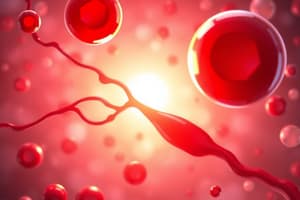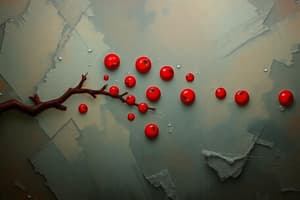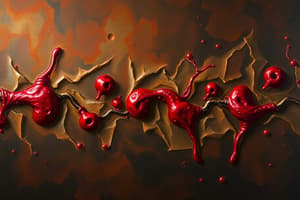Podcast
Questions and Answers
What is the role of thrombin in the coagulation process?
What is the role of thrombin in the coagulation process?
- Converts fibrinogen into fibrin strands (correct)
- Activates Factor XIII to stabilize the clot
- Converts fibrinogen into soluble fibrin
- Transforms prothrombin into fibrin strands
Which of the following coagulation factors is essential for producing factors in the liver?
Which of the following coagulation factors is essential for producing factors in the liver?
- Thrombin
- Factor VII
- Factor XIII
- Vitamin K (correct)
Which inherited disorder is characterized by a deficiency of Factor IX?
Which inherited disorder is characterized by a deficiency of Factor IX?
- Haemophilia C
- Haemophilia B (correct)
- Von Willebrand Disease
- Haemophilia A
What is the main effect of anticoagulants such as Warfarin and Heparin on the clotting cascade?
What is the main effect of anticoagulants such as Warfarin and Heparin on the clotting cascade?
Which process involves the contraction of the clot and helps reduce blood loss?
Which process involves the contraction of the clot and helps reduce blood loss?
What is the role of plasmin in the fibrinolytic process?
What is the role of plasmin in the fibrinolytic process?
Which condition is known to enhance fibrinolysis?
Which condition is known to enhance fibrinolysis?
In the context of coagulation, what is the significance of Factor XIII?
In the context of coagulation, what is the significance of Factor XIII?
What is the primary role of adenosine diphosphate (ADP) in hemostasis?
What is the primary role of adenosine diphosphate (ADP) in hemostasis?
Which condition is likely to result in prolonged bleeding time?
Which condition is likely to result in prolonged bleeding time?
What is the main pathway involved in secondary hemostasis?
What is the main pathway involved in secondary hemostasis?
In primary hemostasis, what forms the platelet plug?
In primary hemostasis, what forms the platelet plug?
What does the Prothrombin Time (PT) measure?
What does the Prothrombin Time (PT) measure?
Which factor initiates the intrinsic pathway of the clotting cascade?
Which factor initiates the intrinsic pathway of the clotting cascade?
What is the normal value range for Activated Partial Thromboplastin Time (aPTT)?
What is the normal value range for Activated Partial Thromboplastin Time (aPTT)?
Which of the following factors is associated with the formation of fibrin from fibrinogen?
Which of the following factors is associated with the formation of fibrin from fibrinogen?
Which stage of haemostasis involves the adherence of platelets to the damaged blood vessel wall?
Which stage of haemostasis involves the adherence of platelets to the damaged blood vessel wall?
What is the primary function of serotonin and thromboxanes during primary haemostasis?
What is the primary function of serotonin and thromboxanes during primary haemostasis?
Which of the following best describes secondary haemostasis?
Which of the following best describes secondary haemostasis?
What role does the von Willebrand factor play in the process of haemostasis?
What role does the von Willebrand factor play in the process of haemostasis?
Which condition can result from severe blood loss as part of the haemostasis process?
Which condition can result from severe blood loss as part of the haemostasis process?
How does the process of vasoconstriction contribute to haemostasis?
How does the process of vasoconstriction contribute to haemostasis?
Which of the following best illustrates a clinical implication of understanding haemostasis for dental professionals?
Which of the following best illustrates a clinical implication of understanding haemostasis for dental professionals?
What is the consequence of insufficient platelets during the platelet plug formation stage of haemostasis?
What is the consequence of insufficient platelets during the platelet plug formation stage of haemostasis?
Flashcards
Prothrombin conversion
Prothrombin conversion
Prothrombin, an inactive protein, is converted into thrombin, an enzyme crucial for blood clotting.
Thrombin's role
Thrombin's role
Thrombin catalyzes the conversion of fibrinogen, a soluble protein, into fibrin, an insoluble fibrous protein.
Fibrin mesh formation
Fibrin mesh formation
Factor XIII stabilizes the fibrin strands, creating a strong mesh that forms the clot.
Coagulation factor sources
Coagulation factor sources
Signup and view all the flashcards
Vitamin K's role
Vitamin K's role
Signup and view all the flashcards
Liver disease & clotting
Liver disease & clotting
Signup and view all the flashcards
Inherited clotting disorders
Inherited clotting disorders
Signup and view all the flashcards
Anticoagulant function
Anticoagulant function
Signup and view all the flashcards
Clot contraction
Clot contraction
Signup and view all the flashcards
Fibrinolysis process
Fibrinolysis process
Signup and view all the flashcards
Fibrinolysis inhibitors
Fibrinolysis inhibitors
Signup and view all the flashcards
Fibrinolysis abnormalities
Fibrinolysis abnormalities
Signup and view all the flashcards
Thrombosis cause
Thrombosis cause
Signup and view all the flashcards
Haemostasis
Haemostasis
Signup and view all the flashcards
Vasoconstriction
Vasoconstriction
Signup and view all the flashcards
Platelet plug formation
Platelet plug formation
Signup and view all the flashcards
Coagulation
Coagulation
Signup and view all the flashcards
Primary Haemostasis
Primary Haemostasis
Signup and view all the flashcards
Secondary Haemostasis
Secondary Haemostasis
Signup and view all the flashcards
Clotting factors
Clotting factors
Signup and view all the flashcards
Blood loss impact
Blood loss impact
Signup and view all the flashcards
Von Willebrand factor
Von Willebrand factor
Signup and view all the flashcards
ADP
ADP
Signup and view all the flashcards
Platelet plug formation
Platelet plug formation
Signup and view all the flashcards
Bleeding time
Bleeding time
Signup and view all the flashcards
Prolonged bleeding time
Prolonged bleeding time
Signup and view all the flashcards
Secondary haemostasis
Secondary haemostasis
Signup and view all the flashcards
Fibrin mesh
Fibrin mesh
Signup and view all the flashcards
Clotting cascade
Clotting cascade
Signup and view all the flashcards
Extrinsic pathway
Extrinsic pathway
Signup and view all the flashcards
Intrinsic pathway
Intrinsic pathway
Signup and view all the flashcards
Prothrombin Time (PT)
Prothrombin Time (PT)
Signup and view all the flashcards
Activated Partial Thromboplastin Time (aPTT)
Activated Partial Thromboplastin Time (aPTT)
Signup and view all the flashcards
Study Notes
Haemostasis Overview
- Haemostasis is the process that stops bleeding.
- When a blood vessel is damaged, overlapping processes occur to halt bleeding.
- Blood loss must be stopped quickly following injury.
GDC Learning Outcomes
- Explain general and systemic diseases, relating them to oral health.
- Describe relevant and appropriate physiology, showing how it applies to patient management.
- Describe medicine properties and therapeutic agents, discussing their impact on patient management.
- Describe haemostasis and clot formation.
- Describe the clotting cascade and the significance of clotting factors
- Outline the significance of haemostasis to dental hygienists/therapists.
What is Haemostasis?
- Bleeding stops through haemostasis.
- When a blood vessel is damaged, multiple overlapping processes halt the blood loss.
Why Haemostasis is Important
- Blood is important connective tissue.
- Blood nourishes all organs.
- It's vital to stop blood loss quickly in case of injury.
Consequences of Rapid Blood Loss
- Minor loss: Body's homeostatic mechanisms preserve blood volume and cells.
- Moderate loss: Headache, fatigue, nausea, sweating, dizziness.
- Severe loss: Clammy skin, rapid shallow breathing, rapid heart rate, little or no urination, confusion, weakness, weak pulse, blue lips/fingernails, lightheadedness, loss of consciousness, and death.
Stages of Haemostasis
- 1. Vasoconstriction: Initial bleeding halted by blood vessel constriction. Platelets adhere to damaged vessel walls.
- 2. Platelet plug formation: Platelets clump around exposed collagen fibers. Von Willebrand factor assists in stabilizing the platelet plug. Platelets release chemicals like ADP to draw in more platelets
- 3. Coagulation (Secondary Haemostasis): Complex process where a stable fibrin clot is formed from liquid fibrinogen through the cascade.
Stages of Primary Haemostasis - 1. Vasoconstriction
- Initial bleeding is stopped by the constriction of blood vessels.
- Platelets stick to damaged vessel walls.
- Platelets release serotonin and thromboxanes, which lead to smooth muscle contraction in the vessel walls.
- Other vasoconstrictors, like endothelins, are released by damaged vessels.
Stages of Primary Haemostasis - 2. Platelet Plug
- Platelets clump at the site of exposed collagen fibres.
- Platelets release substances like adenosine diphosphate (ADP), which draws in more platelets to form a plug.
- Von Willebrand factor stabilizes the platelet plug.
Bleeding Time
- Time taken for primary haemostasis (vessel constriction and platelet plug formation).
- Normal range: 2-7 minutes. Factors that may cause prolonged bleeding times: thrombocytopaenia, severe anaemia, collagen disorders (e.g., Ehlers-Danlos syndrome), Von Willebrand's disease, as well as anti-platelet drugs.
Secondary Haemostasis - 3. Coagulation
- Platelet plug is stabilized through insoluble fibrin strands to form a mesh.
- Fibrin is generated from soluble fibrinogen through the clotting cascade.
Fibrin Mesh
- Fibrin forms a mesh-like structure that entraps blood cells, platelets, and other components, reinforcing the clot.
Clotting Cascade
- A series of steps resulting in the formation of a blood clot in response to bleeding following injury.
- The cascade involves activation of various clotting factors.
Extrinsic Pathway (Tissue Factor Pathway)
- Tissue factor (factor III) in damaged endothelial cells activates factor VII.
- Factor VIIa triggers a cascade of reactions leading to the formation of factor Xa.
- Factor Xa along with Va and calcium activate prothrombin.
Intrinsic Pathway (Contact Pathway)
- Triggered by blood coming into contact with collagen fibers in a damaged blood vessel wall.
- Factor XII (serine protease) is the first key activation step, which is converted to factor XIIa.
- Factor XIIa activation triggers a cascade of reactions ultimately leading to activation of factor X.
Common Pathway
- Prothrombin is converted to thrombin, which converts soluble fibrinogen into fibrin strands.
- Factor XIII acts on the fibrin strands to form a fibrin mesh, stabilizing the clot.
Coagulation Factors
- Synthesized primarily in the liver.
- Vitamin K is essential for the synthesis of several clotting factors.
- Liver disease can impair coagulation factor production.
Inherited Disorders
- Deficiencies in clotting factors (e.g., haemophilia A, B, and C) can occur, impacting the blood's ability to clot appropriately.
Effects of Anticoagulants on the Clotting Cascade
- Anticoagulants block different parts of the clotting cascade, thus preventing blood clotting.
- Examples of anticoagulants include Warfarin, Heparin, and Rivaroxaban.
Clot Retraction
- Clot shrinks and draws the damaged blood vessel edges together, reducing further blood loss.
- Proteins actin and myosin contract within activated platelets.
- Fibrin threads draw more tightly together.
- Serum exudes.
Clot Breakdown (Fibrinolysis)
- Plasminogen is trapped within the clot and converts to plasmin.
- Plasmin breaks down fibrin within the clot.
- Thrombin-activated fibrinolysis inhibitor (TAFI) stabilizes clots.
Fibrinolysis Abnormalities
- Excessive fibrinolysis can lead to bleeding problems.
- Suppressed or impaired fibrinolysis can cause blood clots.
- Example conditions: DVT (deep vein thrombosis), PE (pulmonary embolism)).
Thrombosis
- Caused by either over-activity of coagulation or under-activity of fibrinolysis.
- Often begins in areas of vascular endothelial damage where platelets adhere.
- Formation of clots in blood vessels.
Dental Relevance
- Dental procedures cause bleeding.
- Natural stoppage of bleeding is typically within 4-10 minutes.
- Prolonged bleeding may be caused by various factors, and requires specific management strategies.
Haemorrhage in Dentistry
- Dentistry employs methods like pressure, sutures, and hemostatic agents (e.g., Surgicel) to effectively manage bleeding.
- Electrosurgery units and lasers are less common techniques.
Summary of the Coagulation Cascade
- The presentation details the step-by-step process of clot formation, starting from vascular injury through vasoconstriction, platelet plug formation, coagulation, clot retraction, and lastly fibrinolysis.
Studying That Suits You
Use AI to generate personalized quizzes and flashcards to suit your learning preferences.



